Threshold-Based User-Assisted Cooperative Relaying in Beamspace Massive MIMO NOMA Systems
Abstract
1. Introduction
1.1. Related Works
1.2. Contributions
- We propose threshold-based user-assisted cooperative relaying in beamspace mMIMO NOMA for mmWave communications to improve the overall system and cell-edge MUT performance with low end-to-end latency. To reduce inter- and intra-beam interferences, a zero forcing (ZF) precoder and iterative power allocation are used.
- We compare the performance of this system, CRS beamspace mMIMO NOMA [3], beamspace MIMO-NOMA [4], and MIMO-OMA in a delay-intolerant scenario (A delay-intolerant system refers to a system in which symbols must be received within a specified time frame.). By selecting relaying MUTs based on the signal-to-interference plus noise ratio (SINR) threshold, the cell-edge MUT can receive its symbols in only two transmission phases while maximizing the received SINR.
- We then derive an analytic expression for the outage probability at the cell-edge MUT. This allows us to analyze the proposed system in terms of outage probability and demonstrate its reliability.
- Numerical results revealed that the proposed system achieves superior performance in terms of spectral and energy efficiency. Moreover, the proposed system showed superior performance to CRS beamspace mMIMO NOMA [3], beamspace MIMO-NOMA [4], and MIMO-OMA systems in terms of the outage probability of the cell-edge MUT.
2. System Model
2.1. Network Architecture
- Digital precoder: used to perform the digital baseband signal processing.
2.2. Signal Model
3. Proposed Threshold-Based Cooperative Relaying
3.1. Spectral Efficiency
| Algorithm 1: Threshold-based user-assisted relay selection |
|
3.2. Outage Probability
4. Simulation Results
- A CRS beamspace mMIMO NOMA system, which integrates a beamspace mMIMO system with NOMA and a multi-hop CRS [3].
- A beamspace MIMO-NOMA system, which integrates NOMA and a beamspace MIMO system to serve [4] MUTs.
- A MIMO-OMA system [49] with , in which OMA is performed for IUs within the same beam, and orthogonal frequency resources are allocated for MUTs within the beam.
- The proposed threshold-based user-assisted CRS beamspace mMIMO NOMA system, which integrates beamspace mMIMO NOMA and a threshold-based user-assisted CRS.
4.1. Spectral Efficiency
4.2. Energy Efficiency
4.3. Outage Probability
5. Conclusions
Author Contributions
Funding
Institutional Review Board Statement
Informed Consent Statement
Data Availability Statement
Conflicts of Interest
Abbreviations
| AGN | Additive Gaussian noise |
| GDPC | Generalize dirty paper coding |
| C-MUT | Cell-edge mobile user terminal |
| MRC | Maximal ratio combining |
| SC | Selection combining |
| QR | Quasi-static Rayleigh fading |
| LS | Large-scale path loss |
References
- Zhu, L.; Xiao, Z.; Xia, X.G.; Wu, D.O. Millimeter-wave communications with non-orthogonal multiple access for B5G/6G. IEEE Access 2019, 7, 116123–116132. [Google Scholar] [CrossRef]
- Jiao, R.; Dai, L. On the max-min fairness of beamspace MIMO-NOMA. IEEE Trans. Signal Process. 2020, 68, 4919–4932. [Google Scholar] [CrossRef]
- Kaur, J.; Singh, M.L. User assisted cooperative relaying in beamspace massive MIMO NOMA based systems for millimeter wave communications. China Commun. 2019, 16, 103–113. [Google Scholar] [CrossRef]
- Wang, B.; Dai, L.; Wang, Z.; Ge, N.; Zhou, S. Spectrum and energy-efficient beamspace MIMO-NOMA for millimeter-wave communications using lens antenna array. IEEE J. Sel. Areas Commun. 2017, 35, 2370–2382. [Google Scholar] [CrossRef]
- Ngo, H.Q.; Larsson, E.G.; Marzetta, T.L. Energy and spectral efficiency of very large multiuser MIMO systems. IEEE Trans. Commun. 2013, 61, 1436–1449. [Google Scholar]
- Gao, X.; Dai, L.; Han, S.; Chih-Lin, I.; Heath, R.W. Energy-efficient hybrid analog and digital precoding for mmWave MIMO systems with large antenna arrays. IEEE J. Sel. Areas Commun. 2016, 34, 998–1009. [Google Scholar] [CrossRef]
- Wang, B.; Dai, L.; Gao, X.; Hanzo, L. Beamspace MIMO-NOMA for millimeter-wave communications using lens antenna arrays. In Proceedings of the 2017 IEEE 86th Vehicular Technology Conference (VTC-Fall), Toronto, ON, Canada, 24–27 September 2017; pp. 1–5. [Google Scholar]
- Sayeed, A.; Brady, J. Beamspace MIMO for high-dimensional multiuser communication at millimeter-wave frequencies. In Proceedings of the 2013 IEEE Global Communications Conference (GLOBECOM), Atlanta, GA, USA, 9–13 December 2013; pp. 3679–3684. [Google Scholar]
- Amadori, P.V.; Masouros, C. Low RF-complexity millimeter-wave beamspace-MIMO systems by beam selection. IEEE Trans. Commun. 2015, 63, 2212–2223. [Google Scholar] [CrossRef]
- Pal, R.; Chaitanya, A.K.; Srinivas, K.V. Low-complexity beam selection algorithms for millimeter wave beamspace MIMO systems. IEEE Commun. Lett. 2019, 23, 768–771. [Google Scholar] [CrossRef]
- Gao, X.; Dai, L.; Chen, Z.; Wang, Z.; Zhang, Z. Near-optimal beam selection for beamspace mmWave massive MIMO systems. IEEE Commun. Lett. 2016, 20, 1054–1057. [Google Scholar] [CrossRef]
- Gao, X.; Dai, L.; Sayeed, A.M. Low RF-complexity technologies to enable millimeter-wave MIMO with large antenna array for 5G wireless communications. IEEE Commun. Mag. 2018, 56, 211–217. [Google Scholar] [CrossRef]
- Tang, S.; Ma, Z.; Xiao, M.; Hao, L. Hybrid transceiver design for beamspace MIMO-NOMA in code-domain for mmWave communication using lens antenna array. IEEE J. Sel. Areas Commun. 2020, 38, 2118–2127. [Google Scholar] [CrossRef]
- Alimo, D.; Saito, M. Beam selection for mm-wave massive MIMO systems using ACO & combined digital precoding under hybrid transceiver architecture. IEICE Commun. Express 2020, 9, 170–175. [Google Scholar]
- Zeng, Y.; Zhang, R. Millimeter wave MIMO with lens antenna array: A new path division multiplexing paradigm. IEEE Trans. Commun. 2016, 64, 1557–1571. [Google Scholar] [CrossRef]
- Brady, J.; Behdad, N.; Sayeed, A.M. Beamspace MIMO for millimeter-wave communications: System architecture, modeling, analysis, and measurements. IEEE Trans. Antennas Propag. 2013, 61, 3814–3827. [Google Scholar] [CrossRef]
- Qian, L.; Wu, Y.; Yu, N.; Jiang, F.; Zhou, H.; Quek, T.Q.S. Learning driven NOMA assisted vehicular edge computing via underlay spectrum sharing. IEEE Trans. Veh. Technol. 2021, 70, 977–992. [Google Scholar] [CrossRef]
- Sabuj, S.R.; Asiedu, D.K.P.; Lee, K.J.; Jo, H.S. Delay optimization in mobile edge computing: Cognitive UAV-assisted eMBB and mMTC services. IEEE Trans. Cogn. Commun. Netw. 2022, 8, 1019–1033. [Google Scholar] [CrossRef]
- Do, T.N.; da Costa, D.B.; Duong, T.Q.; An, B. Improving the performance of cell-edge users in NOMA systems using cooperative relaying. IEEE Trans. Commun. 2018, 66, 1883–1901. [Google Scholar] [CrossRef]
- Cui, J.; Liu, Y.; Ding, Z.; Fan, P.; Nallanathan, A. Optimal user scheduling and power allocation for millimeter wave NOMA systems. IEEE Trans. Wirel. Commun. 2017, 17, 1502–1517. [Google Scholar] [CrossRef]
- Zhu, L.; Zhang, J.; Xiao, Z.; Cao, X.; Wu, D.O.; Xia, X.G. Millimeter-wave NOMA with user grouping, power allocation and hybrid beamforming. IEEE Trans. Wirel. Commun. 2019, 18, 5065–5079. [Google Scholar] [CrossRef]
- Wei, Z.; Zhao, L.; Guo, J.; Ng, D.W.K.; Yuan, J. Multi-beam NOMA for hybrid mmWave systems. IEEE Trans. Commun. 2018, 67, 1705–1719. [Google Scholar] [CrossRef]
- Dai, L.; Wang, B.; Peng, M.; Chen, S. Hybrid precoding-based millimeter-wave massive MIMO-NOMA with simultaneous wireless information and power transfer. IEEE J. Sel. Areas Commun. 2018, 37, 131–141. [Google Scholar] [CrossRef]
- Gandotra, P.; Jha, R.K. Device-to-device communication in cellular networks: A survey. J. Netw. Comput. Appl. 2016, 71, 99–117. [Google Scholar] [CrossRef]
- Elkotby, H.; Vu, M. Uplink user-assisted relaying in cellular networks. IEEE Trans. Wirel. Commun. 2015, 14, 5468–5483. [Google Scholar] [CrossRef]
- Lee, J.; Lee, J.H. Performance analysis and resource allocation for cooperative D2D communication in cellular networks with multiple D2D pairs. IEEE Commun. Lett. 2019, 23, 909–912. [Google Scholar] [CrossRef]
- Wang, S.; Guo, W.; Zhou, Z.; Wu, Y.; Chu, X. Outage probability for multi-hop D2D communications with shortest path routing. IEEE Commun. Lett. 2015, 19, 1997–2000. [Google Scholar] [CrossRef]
- Odeh, N.; Abolhasan, M.; Safaei, F. Low complexity interference aware distributed resource allocation for multi-cell OFDMA cooperative relay networks. In Proceedings of the IEEE Wireless Communications and Networking Conference, WCNC, Sydney, Australia, 18–21 April 2010. [Google Scholar]
- Vanganuru, K.; Puzio, M.; Sternberg, G.; Shah, K.; Kaur, S. Uplink system capacity of a cellular network with cooperative mobile relay. In Proceedings of the Wireless Telecommunications Symposium, New York, NY, USA, 13–15 April 2011. [Google Scholar]
- Liau, Q.Y.; Leow, C.Y. Successive user relaying in cooperative NOMA system. IEEE Wirel. Commun. Lett. 2019, 8, 921–924. [Google Scholar] [CrossRef]
- Kara, F.; Kaya, H. Threshold-Based Selective Cooperative-NOMA. IEEE Commun. Lett. 2019, 23, 1263–1266. [Google Scholar] [CrossRef]
- Kara, F.; Kaya, H. Threshold-Based Selective Cooperative NOMA: Capacity/Outage Analysis and a Joint Power Allocation-Threshold Selection Optimization. IEEE Commun. Lett. 2020, 24, 1929–1933. [Google Scholar] [CrossRef]
- Le, V.A.; Pitaval, R.A.; Blostein, S.; Riihonen, T.; Wichman, R. Green cooperative communication using threshold-based relay selection protocols. In Proceedings of the 2010 International Conference on Green Circuits and Systems, Paris, France, 30 May–2 June 2010; pp. 521–526. [Google Scholar]
- Xie, X.; Liu, J.; Huang, J.; Zhao, S. Ergodic capacity and outage performance analysis of uplink full-duplex cooperative NOMA system. IEEE Access 2020, 8, 164786–164794. [Google Scholar] [CrossRef]
- Jiao, R.; Dai, L.; Zhang, J.; MacKenzie, R.; Hao, M. On the performance of NOMA-based cooperative relaying systems over Rician fading channels. IEEE Trans. Veh. Technol. 2017, 66, 11409–11413. [Google Scholar] [CrossRef]
- Abbasi, O.; Ebrahimi, A.; Mokari, N. NOMA inspired cooperative relaying system using an AF relay. IEEE Wirel. Commun. Lett. 2019, 8, 261–264. [Google Scholar] [CrossRef]
- Huang, C.; Chen, G.; Gong, Y.; Xu, P.; Han, Z.; Chambers, J.A. Buffer-Aided Relay Selection for Cooperative Hybrid NOMA/OMA Networks with Asynchronous Deep Reinforcement Learning. IEEE J. Sel. Areas Commun. 2021, 39, 2514–2525. [Google Scholar] [CrossRef]
- Kim, J.B.; Lee, I.H. Capacity analysis of cooperative relaying systems using non-orthogonal multiple access. IEEE Commun. Lett. 2015, 19, 1949–1952. [Google Scholar] [CrossRef]
- El-Zahr, S.; Abou-Rjeily, C. Threshold based relay selection for buffer-aided cooperative relaying systems. IEEE Trans. Wirel. Commun. 2021, 20, 6210–6223. [Google Scholar] [CrossRef]
- Zaidi, A.; Vandendorpe, L. Rate regions for the partially-cooperative relay broadcast channel with non-causal side information. IEEE Int. Symp. Inf. Theory—Proc. 2007, 1, 1246–1250. [Google Scholar]
- Zaidi, A.; Vandendorpe, L.; Duhamel, P. Lower bounds on the capacity regions of the relay channel and the cooperative relay-broadcast channel with non-causal side information. In Proceedings of the 2007 IEEE International Conference on Communications, Glasgow, UK, 24–28 June 2007; pp. 6005–6011. [Google Scholar]
- Yue, X.; Liu, Y.; Kang, S.; Nallanathan, A.; Ding, Z. Exploiting Full/Half-Duplex User Relaying in NOMA Systems. IEEE Trans. Commun. 2018, 66, 560–575. [Google Scholar] [CrossRef]
- Guo, N.; Ge, J.; Bu, Q.; Zhang, C. Multi-User Cooperative Non-Orthogonal Multiple Access Scheme with Hybrid Full/Half-Duplex User-Assisted Relaying. IEEE Access 2019, 7, 39207–39226. [Google Scholar] [CrossRef]
- Kundu, C.; Ngatched, T.M.N.; Dobre, O.A. Relay selection to improve secrecy in cooperative threshold decode-and-forward relaying. In Proceedings of the 2016 IEEE Global Communications Conference (GLOBECOM), Washington, DC, USA, 4–8 December 2016; pp. 1–6. [Google Scholar]
- Xiao, M.; Mumtaz, S.; Huang, Y.; Dai, L.; Li, Y.; Matthaiou, M.; Karagiannidis, G.K.; Björnson, E.; Yang, K.; Chih-Lin, I. Millimeter wave communications for future mobile networks. IEEE J. Sel. Areas Commun. 2017, 35, 1909–1935. [Google Scholar] [CrossRef]
- Gao, X.; Dai, L.; Han, S.; Chih-Lin, I.; Wang, X. Reliable Beamspace Channel Estimation for Millimeter-Wave Massive MIMO Systems with Lens Antenna Array. IEEE Trans. Wirel. Commun. 2017, 16, 6010–6021. [Google Scholar] [CrossRef]
- Nazzal, M.; Aygul, M.A.; Gorcin, A.; Arslan, H. Dictionary learning-based beamspace channel estimation in millimeter-wave massive MIMO systems with a lens antenna array. In Proceedings of the 2019 15th International Wireless Communications and Mobile Computing Conference, IWCMC 2019, Tangier, Morocco, 24–28 June 2019; pp. 20–25. [Google Scholar]
- Hossain, E.; Kim, D.I.; Bhargava, V.K. Cooperative Cellular Wireless Networks; Cambridge University Press: Cambridge, MA, USA, 2011. [Google Scholar]
- Liu, Y.; Pan, G.; Zhang, H.; Song, M. On the capacity comparison between MIMO-NOMA and MIMO-OMA. IEEE Access 2016, 4, 2123–2129. [Google Scholar] [CrossRef]
- Nguyen, N.T.; Lee, K. Coverage and cell-edge sum-rate analysis of mmWave massive MIMO systems with ORP schemes and MMSE receivers. IEEE Trans. Signal Process. 2018, 66, 5349–5363. [Google Scholar] [CrossRef]
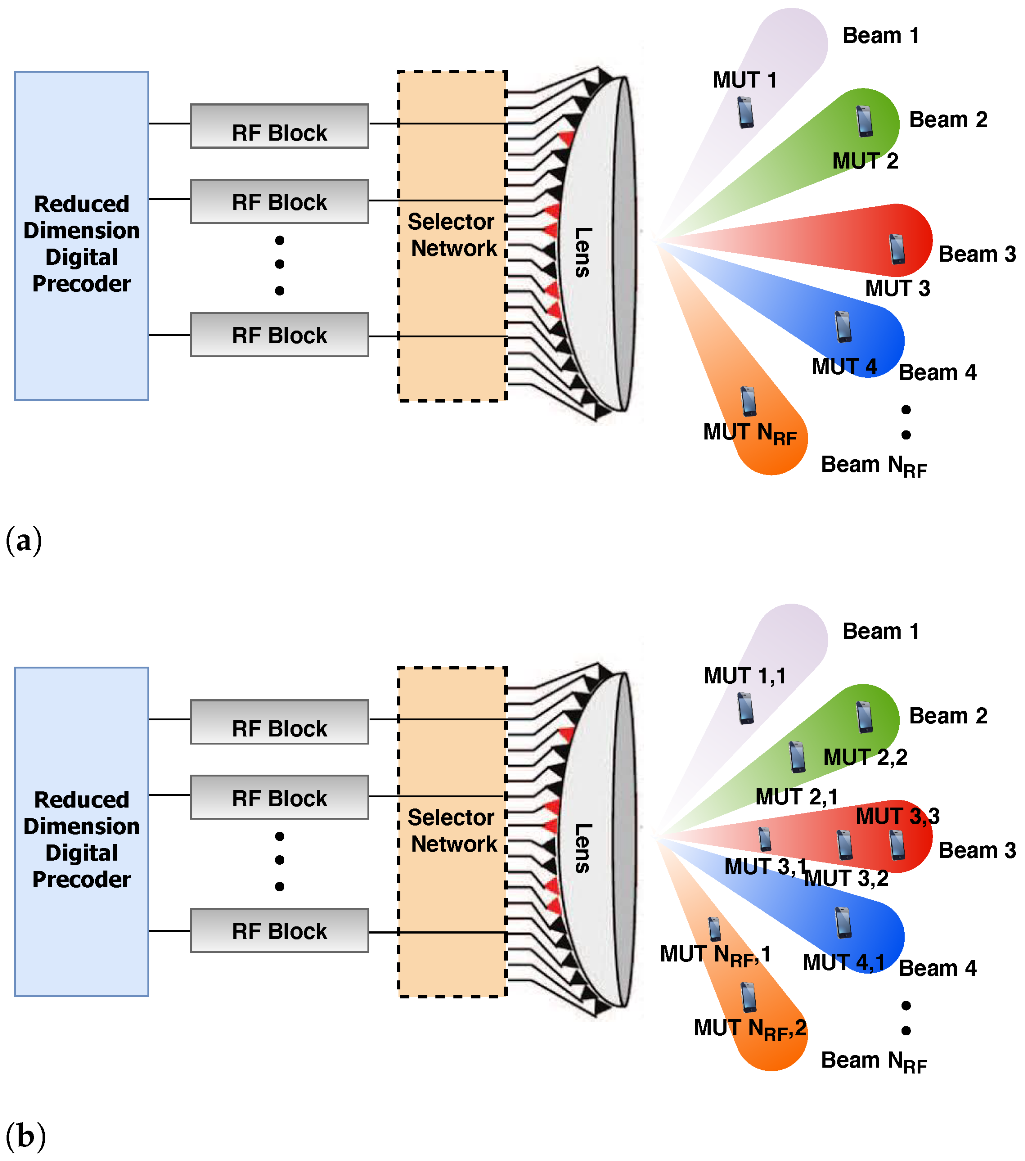

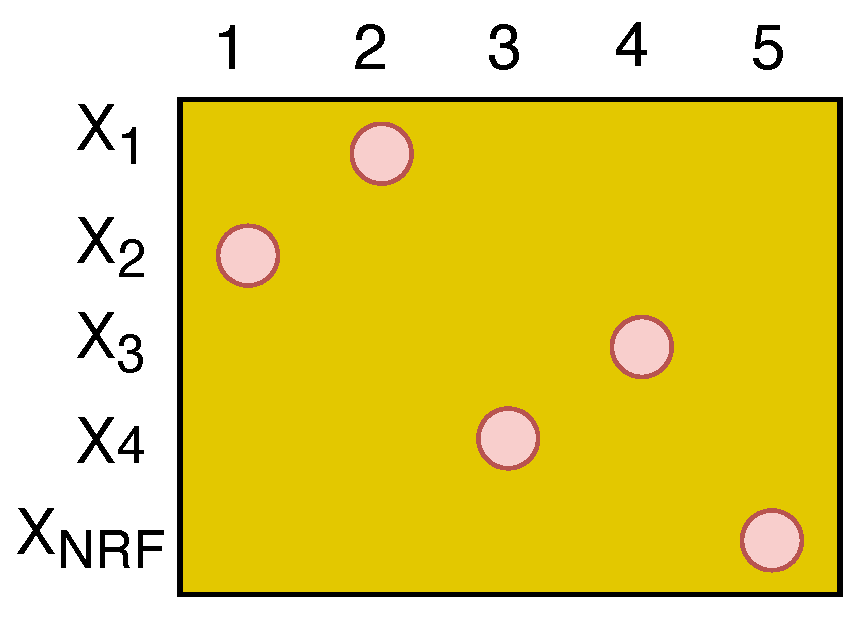

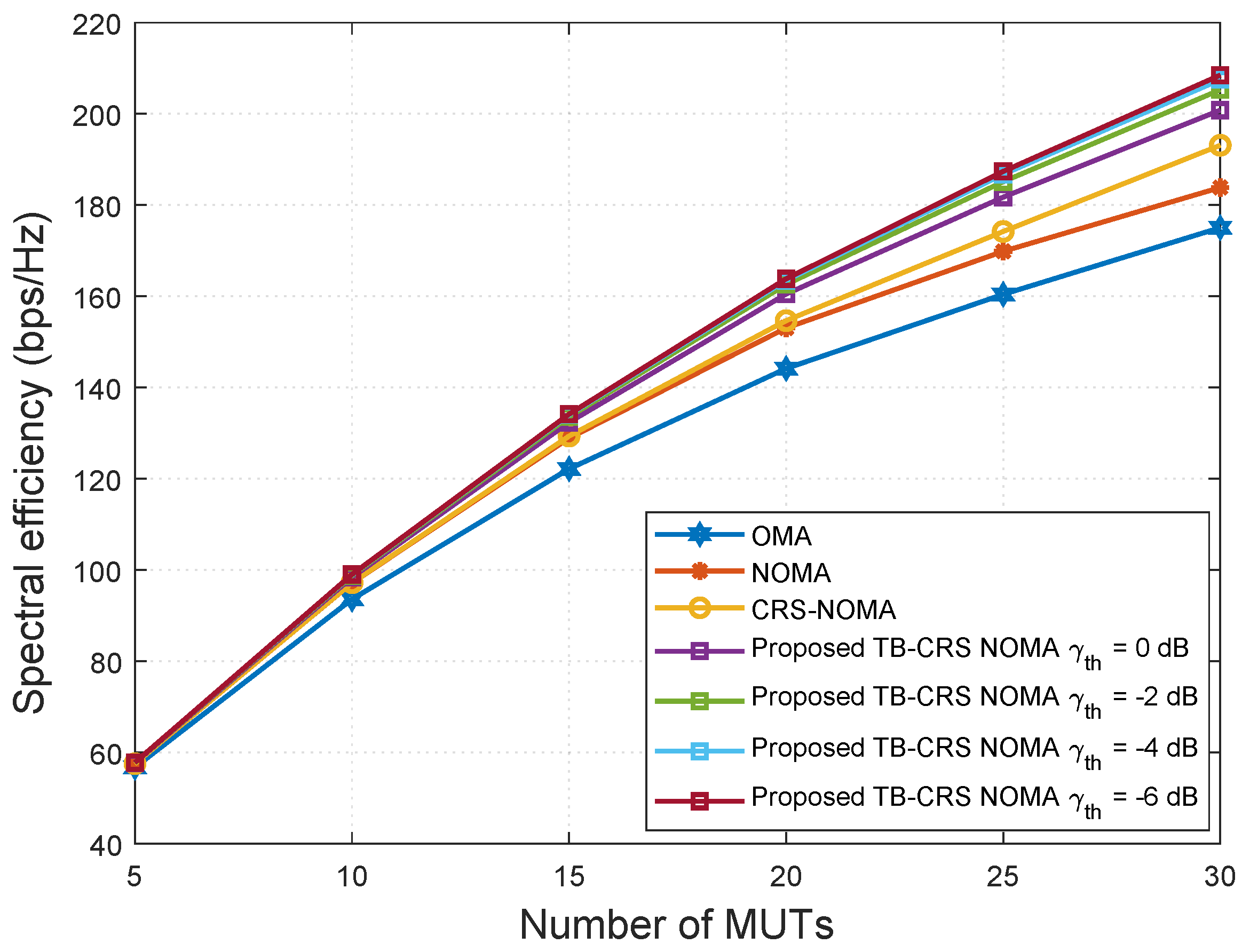
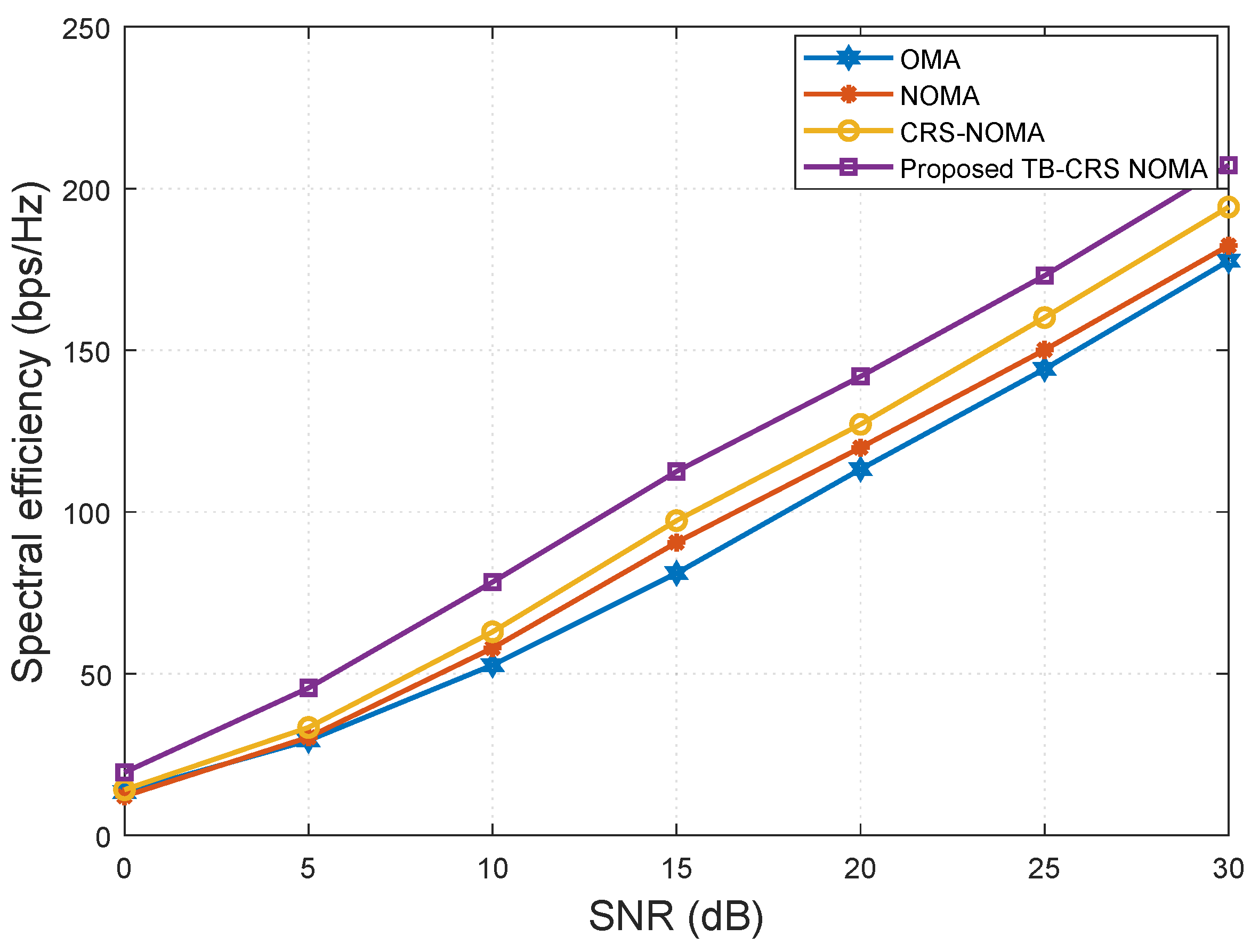

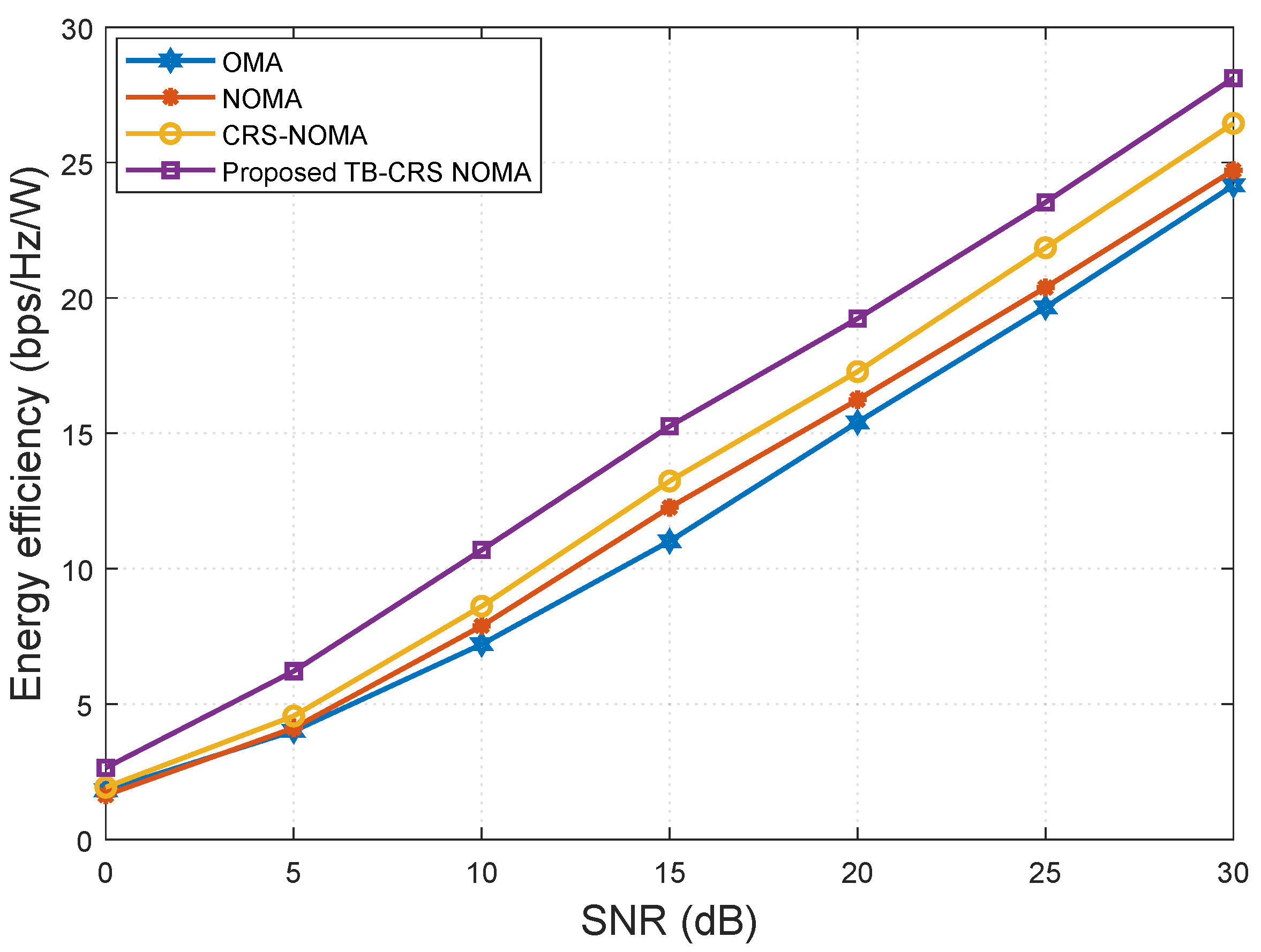

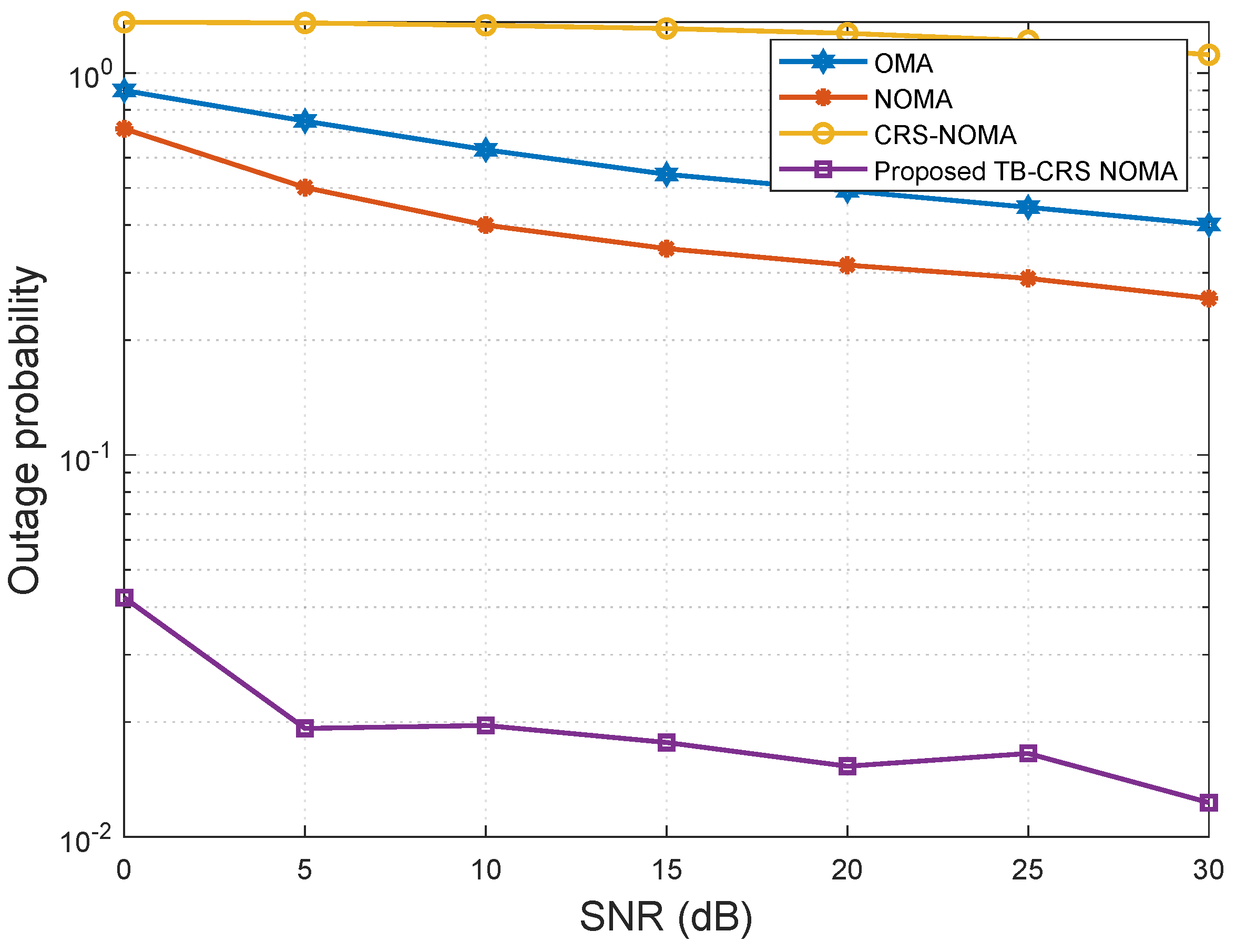
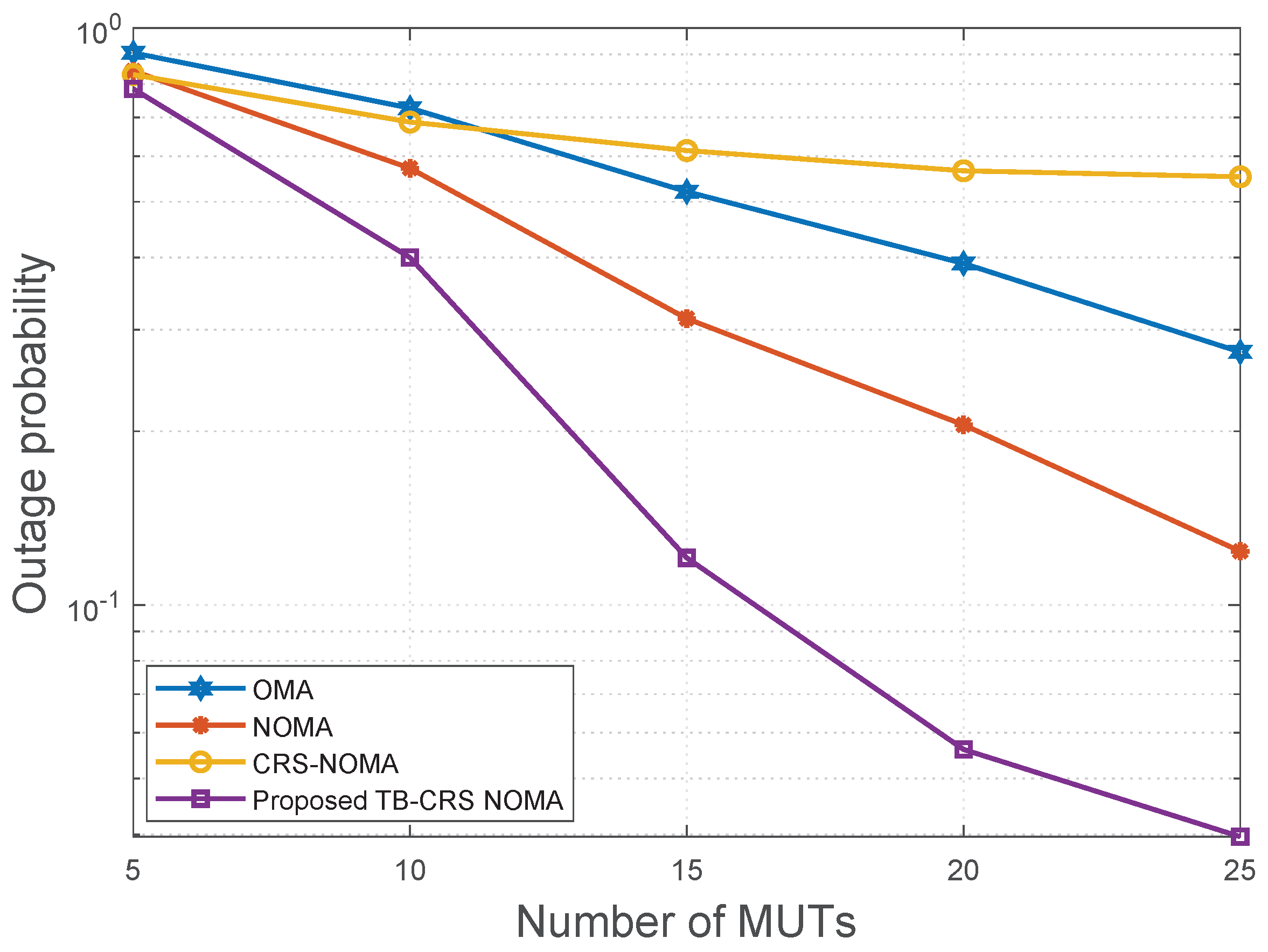
| [36] | [43] | [37] | [40] | [41] | [32] | Current work | |
|---|---|---|---|---|---|---|---|
| Channel | AGN | QR + LS | QR | Discrete AGN | AGN | mmWave | mmWave |
| Uplink | |||||||
| Downlink | ✓ | ✓ | ✓ | ✓ | ✓ | ✓ | ✓ |
| D2D | |||||||
| Dedicated relay | ✓ | ✓ | Partial | Partial | |||
| User-assisted CRS | ✓ | ✓ | ✓ | ||||
| Duplex mode | Half | Full/Half | Half | Half | Half | Half | Half |
| Decode-and-forw. | ✓ | ✓ | ✓ | ✓ | ✓ | ✓ | |
| Amplify-and-forw. | ✓ | ||||||
| Multi-hop | ✓ | ||||||
| Multi-relay | ✓ | ✓ | ✓ | per beam | per beam | ||
| Single-relay | ✓ | ✓ | |||||
| Destination | 1 | 2 | 2 | 1 | 1 | 1 per beam | 1 per beam |
| Combining | 2 MRC | SC | MRC | ||||
| SIC | 2 | ✓ | ✓ | Relay | Relay | Relay | Relay & C-MUT |
| Threshold-based | ✓ | ||||||
| Buffer-aided | ✓ | ||||||
| Outage probability | ✓ | ✓ | ✓ | ||||
| Sum rate | Rate region | ✓ | ✓ | ||||
| Energy efficiency | ✓ | ✓ | |||||
| Throughput | ✓ | ✓ | ✓ | ||||
| Ergodic capacity | ✓ | ✓ | |||||
| Multiple access | NOMA | NOMA | NOMA/OMA | NOMA | NOMA | ||
| Message splitting | ✓ | ||||||
| Precoding | GDPC | ZF | ZF | ||||
| Time slot | 2 | 2 + buffer delay | 2 | 2 | No. of MUTs | 2 |
Publisher’s Note: MDPI stays neutral with regard to jurisdictional claims in published maps and institutional affiliations. |
© 2022 by the authors. Licensee MDPI, Basel, Switzerland. This article is an open access article distributed under the terms and conditions of the Creative Commons Attribution (CC BY) license (https://creativecommons.org/licenses/by/4.0/).
Share and Cite
Alimo, D.; Hamamura, M.; Sabuj, S.R. Threshold-Based User-Assisted Cooperative Relaying in Beamspace Massive MIMO NOMA Systems. Sensors 2022, 22, 7445. https://doi.org/10.3390/s22197445
Alimo D, Hamamura M, Sabuj SR. Threshold-Based User-Assisted Cooperative Relaying in Beamspace Massive MIMO NOMA Systems. Sensors. 2022; 22(19):7445. https://doi.org/10.3390/s22197445
Chicago/Turabian StyleAlimo, David, Masanori Hamamura, and Saifur Rahman Sabuj. 2022. "Threshold-Based User-Assisted Cooperative Relaying in Beamspace Massive MIMO NOMA Systems" Sensors 22, no. 19: 7445. https://doi.org/10.3390/s22197445
APA StyleAlimo, D., Hamamura, M., & Sabuj, S. R. (2022). Threshold-Based User-Assisted Cooperative Relaying in Beamspace Massive MIMO NOMA Systems. Sensors, 22(19), 7445. https://doi.org/10.3390/s22197445






